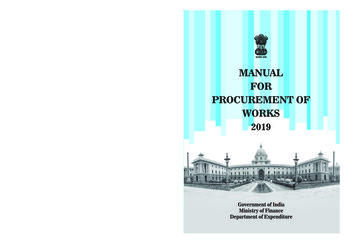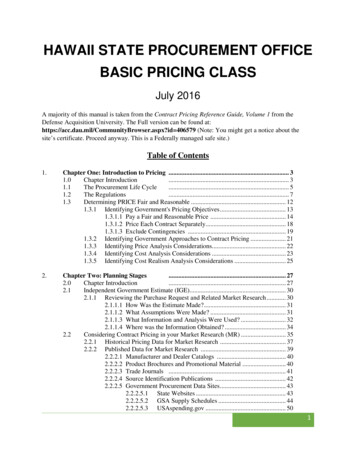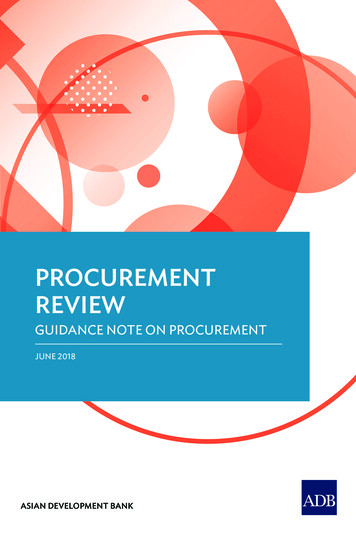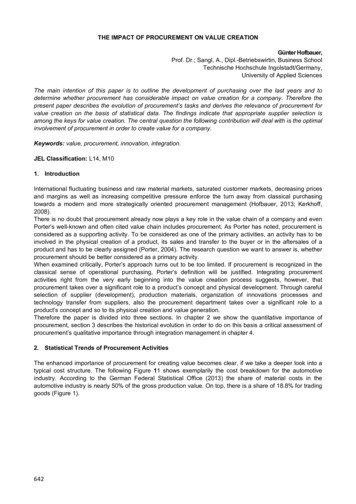
Transcription
ManualforProcurement ofWorks2019Government of IndiaMinistry of FinanceDepartment of Expenditure
Foreword1.Government organizations procure a wide variety of goods and services and undertakeexecution of works in pursuance of their duties and responsibilities. With a view toimproving transparency in decision making in public procurement and reducing thescope for subjectivity, Department of Expenditure in 2006 had prepared a set of threeManuals on Policies and Procedures for Procurement of Goods, Works and hiring ofConsultants, in conformity with the General Financial Rules (GFR), 2005. Over the years,these Manuals have served as a guide book for procurement.2.In the last few years, the Government of India has issued new instructions in the domainof public procurement. Some of these important changes include introduction of CentralPublic Procurement Portal (CPPP), preference for domestic contractors, inclusion of integritypact, etc. The GFR has been revised comprehensively in March 2017 covering inter-aliathese set of new instructions. Consequently, the Manual of Procurement of Goods andManual for Procurement of Consultancy & Other Services too have been revised.3.The new Manual on Procurement of Works has been extensively revised in keeping withGFR 2017 and in consonance with the fundamental principles of transparency, fairness,competition, economy, efficiency and accountability. Efforts have been made to coverall major aspects of procurement in this Manual in a user-friendly manner. The manualis the outcome of extensive consultations with Ministries/ Departments/ PSUs and otherorganizations over a period of more than one year.4.Manuals issued by this Department are to be taken as generic guidelines, which haveto be necessarily broad in nature. Ministries/ Departments are advised to supplementthis manual to suit their local/ specialized needs, by issuing their own detailedmanuals (including customized formats); Standard Bidding Documents and Schedule ofProcurement Powers to serve as detailed instructions for their own procuring officers.5.I would like to acknowledge the efforts taken by Shri Sanjay Prasad, Joint Secretary(PF C-II), Shri Sanjay Aggarwal, Director (PPD), Shri Kotluru Narayana Reddy, DeputySecretary (PPD) and Shri Girish Bhatnagar, Consultant (Public Procurement) in revision ofthis Manual. I would also like to thank the Ministries, Departments, other organisationsand individuals who reviewed the drafts of the Manual and provided their valuableinputs.6.I hope that this Manual would be useful to procuring officials working in various Ministries/Departments as operating instructions and will bring about greater transparency andpredictability in government procedures and help in improving the ease of doing businesswith the Government.Date : 06.06.2019(G. C. Murmu)Secretary (Expenditure)
Manual for Procurement of Works 2019Manual for Procurement of Goods 2017Ministryof ofFinanceMinistryFinanceDepartmentof ExpenditureDepartmentof ExpenditureCAUTIONWhile every care has been taken to ensure that the contents of this Manual are accurateand up to date till March 2019, the procuring entities are advised to check the precisecurrent provisions of extant law and other applicable instruction from the original sources.In case of any conflict between the provisions stipulated in this Manual and in the originalsources. Such as GFR or the prevailing laws, the provisions contained in the extant lawand the original instructions shall prevail.v
Table ofContentsManual for Procurement of Works 2019Ministry of FinanceDepartment of ExpenditureTable of ContentsForewordiiiCautionvTable of ContentsviiAbbreviations and AcronymsxvProcurement GlossaryxixCHAPTERSChapter 1: Introduction to Procurement of Works11.1Procurement Rules and Regulations; and this Manual11.2Clarification, Amendments and Revision of this Manual11.3Applicability of this Manual21.4Basic Aims of Procurement – Five R’s of Procurement31.5Fundamental Principles of Public Procurement31.6Standards (Canons) of Financial Propriety41.7Public Procurement Infrastructure at the Centre41.8 Legal Aspects Governing Public Procurement of Works51.96The Law of Agency – applicable to Procurement of Works1.10 The Basic Principles of undertaking works61.11 Processing of Public Works91.12 Administrative Control and Powers to Sanction9Chapter 2: Preparation of Estimates112.1Perspective Planning for works112.2Preparation of Preliminary Project Report (PPR) or Rough Cost Estimate112.3Acceptance of necessity and issue of in-Principle Approval122.4Preparation of Detailed Project Report (DPR) /Preliminary Estimates (PE)12vii
Manual for Procurement of Works 2019Ministry of FinanceDepartment of ExpenditureTable ofContents2.5Administrative Approval and Expenditure Sanction (A/A and E/S)142.6Detailed Designs, Detailed Estimates and Technical Sanction142.7Appropriation of funds142.8Reference Documents used in preparation of Estimates152.9Procurement Planning15Chapter 3: Agency for Procurement, Types of Contract,Bidding Systems and Modes of Procurement3.116Agency for Procurement163.1.1Directly by the Ministry/ Department163.1.2Public Works Organisations163.1.3Public Works PSU/ Organisations163.1.4Procedure for Assigning Work to PWO or PSU/ Organisations163.2Types of Contract173.2.1 Lump sum (Fixed Price) Contract183.2.2Item rate (Unit Rate) Contract193.2.3Percentage Rate Contract193.2.4Piece Work Contract193.2.5Engineering, Procurement and Construction (EPC) Contracts203.2.6Public Private Partnership (PPP)223.3Bidding Systems223.3.1Single Stage Bidding System223.3.2Single Stage Single Bid/ Envelope System (1S1E)223.3.3Single Stage Two Envelope Systems (1S2E)223.3.4Single Stage Multiple Envelope System (with post-qualification, 1S3E) 233.3.5Two Stage Bidding with Expression of Interest (EoI)viii23
Table ofContentsManual for Procurement of Works 2019Ministry of FinanceDepartment of Expenditure3.3.6Pre-qualification Bidding (PQB)263.3.7Pre-Qualification Bidding – Risks and Mitigations:313.4Electronic Procurement (e-Procurement)313.5Modes of Tendering323.5.1Open Tender Enquiry (OTE)323.5.2OTE - Risks and Mitigations333.5.3Global Tender Enquiry (GTE)343.5.4GTE - Risks and Mitigations353.5.5 Limited Tender Enquiry (LTE)353.5.6 LTE - Risks and Mitigations363.5.7Single Tender Enquiry (STE) or Selection by Nomination373.5.8SLTE - Risks and Mitigations383.5.9Award of Work through Quotations38Chapter 4: Preparing Bid Documents, Publication,Receipt and Opening of Bids394.1Bid Documents394.2Preparation of Bid Documents by Procuring Entity404.3Publication of Bid Documents414.4Issue/ Availability and Cost of tender documents434.5Eligibility and Qualifications of Bidders434.6Clarification of Tender Documents444.7Amendment of Tender Documents444.8Pre-bid Conference454.9Submission of Bids by Bidders454.10 Receipt and Opening of Bids47ix
Manual for Procurement of Works 2019Ministry of FinanceDepartment of ExpenditureTable ofContents4.11 Bid Security/ Earnest Money Deposit (EMD)494.12 Performance Guarantee494.13 Security Deposit/ Retention Money504.14 Sources and Verification of Bank Guarantees514.15 Safe Custody and Monitoring of Securities514.16 Goods and Services Tax (GST)524.17 Risks and Mitigations - Preparing Bid Documents, Publication,Receipt and Opening of Bids53Chapter 5: Evaluation of Bids and Award of Work555.1Evaluation of Bids555.2Schedule of Procurement Powers (SoPP)555.3Preparation of Comparative Statement and Briefing Note565.4Preliminary Examination565.5Evaluation of Responsive Bids585.6Deliberations by the Tender Committee615.7Award of Work675.8Evaluation of Bids and Award of Contract - Risks and Mitigations71Chapter 6: Execution and Monitoring of Works and Quality Assurance736.1Execution and Monitoring of Work736.2Quality Assurance756.3Design Approvals766.4Time Monitoring766.4.1Time At Large766.4.2Force Majeure (FM) Clause766.4.3Delays in Execution76x
Table ofContentsManual for Procurement of Works 2019Ministry of FinanceDepartment of Expenditure6.4.4 Liquidated Damages and Incentives/ Bonus776.4.5776.5Extension of Time (EOT)Financial Monitoring776.5.1Variations/ Extra/ Substituted Items786.5.2Measurement and Payment796.5.3Mobilization Advance816.5.4Plant, Machinery and shuttering Material Advance816.5.5Secured Advance against Material brought to Site826.5.6Price Variation826.66.7Commissioning and Documentation83Closure of Contract836.7.1Completion of Contract836.7.2Material and Works Reconciliation846.7.3Reconciliation with the User Department846.7.4Payment Reconciliation846.8Dispute Resolution Mechanism856.9Conciliation856.10 Arbitration856.11 Breach of Contract, Remedies and Termination866.11.1 Breach of Contract866.11.2 Cancellation of Contract for Default866.11.3 Termination of Contract for Insolvency876.11.4 Termination of Contract for Procuring Entity’s Failure or Convenience876.12 Preparation of Revised Project Reportxi87
Manual for Procurement of Works 2019Ministry of FinanceDepartment of ExpenditureTable ofContentsChapter 7: Registration/Enlistment of Contractors andGovernance Issues897.1Contractor Relationship Management897.2Code of Integrity for Public Procurement (CIPP)897.2.1Introduction897.2.2Code of Integrity for Public Procurement897.2.3Obligations for Proactive Disclosures907.2.4Punitive Provisions917.2.5Conduct of Public Servants in Public Procurement –Risks and Mitigations917.3Integrity Pact (IP)927.4Development of New Sources and Registration/ Enlistment of Contractors947.5Debarment987.6Project Management98xii
AnnexureManual for Procurement of Works 2019Ministry of FinanceDepartment of ExpenditureAnnexureAnnexure1:Procurement Guidelines107Annexure2:Bid Opening Attendance Sheet cum Report108Annexure3:Tender Committee Minutes Format109Annexure4:Invitation and Declaration for Negotiations111Annexure5:Format of Revised Offer in Negotiations112Annexure6:Letter (Notification) of Award (LOA) of Contract113Annexure7:No Claim Certificate114Annexure8:A Sample MOU115Annexure9:Flowchart of Process of Procurement of Works124Additional Resources relating to Procurement of Works126Annexure 10:xiii
Manual for Procurement of Works 2019Ministry of FinanceDepartment of ExpenditureAppendixAppendixAppendix 1:Advanced Concepts of Value for Money andFundamental Principles of Public Procurement1291.0The Concept of Value1292.0Total Cost of Ownership1293.0Value for Money1304.0Fundamental Principles of Public Procurement131Appendix 2: Legal Aspects of Public Procurement1351.0Relevant Provisions of the Constitution of India1352.0Salient Features of the Indian Contract Act1363.0Salient Features of the Indian Arbitration & Conciliation Act 1996and Arbitration and Conciliation (Amendment) Act, 20151424.0Salient Features of Competition Act, 2002 relating toAnti-competitive Practices1465.0Salient Features of the Whistle Blowers Protection Act, 2011and the Whistle Blowers Protection (Amendment) Act, 2015150Appendix 3: Electronic Procurement (e-Procurement)1531.0Electronic procurement (e-procurement)1532.0Service Provider1533.0Process154xiv
Abbreviationsand AcronymsManual for Procurement of Works 2019Ministry of FinanceDepartment of ExpenditureAbbreviations and AcronymsAAECAppreciable Adverse Effect on CompetitionAITBAppendix to Instructions to Bidders (ITB, also named as BDS, sometimes, see below)BC (selling) Bill for Collection Selling (Foreign Exchange) RateBDSBid Data SheetBGBank GuaranteeBISBureau of Indian StandardsBOCBid Opening CommitteeBOQBill of QuantitiesBROBorder Roads OrganisationC&AGComptroller and Auditor General (of India)CACompetent AuthorityCBICentral Bureau of InvestigationCCICompetition Commission of IndiaCECConsultancy Evaluation CommitteeCIPPCode of Integrity for Public ProcurementCMCContract Management CommitteeCPOCentral Purchasing OrganizationsCPPPCentral Public Procurement PortalCPSECentral Public Sector Enterprise, see PSU alsoCPWDCentral Public Works DepartmentCVCurriculum VitaeCVCCentral Vigilance CommissionCVOChief Vigilance OfficerDFPRDelegation of Financial PowerDGDirector GeneralDGS&DDirectorate General of Supplies and DisposalsDLCDefect Liability CertificateDLPDefect Liability Periodxv
Manual for Procurement of Works 2019Ministry of FinanceDepartment of ExpenditureAbbreviationsand AcronymsDoEDepartment of ExpenditureDPRDetailed Project ReportDSCDigital Signature CertificateDSPEDelhi Special Police Establishment Act, 1946ECEvaluated CostECSElectronic Clearing SystemEIAEnvironmental impact assessmentEMDEarnest Money DepositEOIExpression of Interest (Tender)EPCEngineering, Procurement and ConstructionEPFEmployee Provident FundESIEmployee State InsuranceFAFinancial AdvisorFBSFixed Budget SystemFEMAForeign Exchange Management ActFMForce MajeureFTPFull Technical ProposalGCCGeneral Conditions of ContractGePNICGovernment e-Procurement (System) of National Informatics CentreGFRGeneral and Financial Rules, 2017GOIGovernment of IndiaGTEGlobal Tender EnquiryHODHead of the DepartmentHUFHindu Undivided FamilyICTInformation & Communications TechnologyIEMIndependent External MonitorIPIntegrity PactISOInternational Organization for StandardizationITInformation Technologyxvi
Abbreviationsand AcronymsManual for Procurement of Works 2019Ministry of FinanceDepartment of ExpenditureITBInstructions to Bidders (may in some instance be called Instructions to Tenderers- ITT)ITCInstructions to ConsultantsITJIndian Trade JournalJVJoint Venture (Consortium)L1 Lowest BidderL2Second Lowest BidderL3Third Lowest BidderLCC Life Cycle CostLCS Least Cost SystemLD Liquidated DamagesLEC Lowest Evaluated CostLOA Letter of AcceptanceLOI Letter of InvitationLTE Limited Tender EnquiryMBMeasurement BookMESMilitary Engineering ServiceMoFMinistry of FinanceMOUMemorandum of Understanding (of JV)MoUDMinistry of Urban DevelopmentMSTCMetal Scrap Trading CorporationNGONon Government OrganisationNICNational Informatics CentreNITNotice Inviting TenderOTEOpen Tender EnquiryPANPersonal Account NumberPBGPerformance Bank GuaranteePOLPetroleum Oils and LubricantsPPDProcurement Policy DivisionPPPPublic Private Partnershipxvii
Manual for Procurement of Works 2019Ministry of FinanceDepartment of ExpenditurePPRPreliminary Project ReportPQBPrequalification BiddingPQCPre-qualification CriteriaPSARAPrivate Security Agencies Regulation Act, 2005Abbreviationsand Acronyms(C)PSU/PSE (Central) Public Sector Undertaking/ EnterprisePWOPublic Works OrganisationsQAQuality AssuranceQCBSQuality and Cost Based Selection(S)RFP(Standard) Request for Proposals (Document)RFQRequest for QualificationRTIRight to Information (Act)SBDStandard Bidding DocumentSCCSpecial Conditions of ContractSDSecurity DepositSLAService Level AgreementSoPPSchedule of Procurement PowersSORSchedule of RatesSSS/ STESingle Source Selection/ Single Tender EnquirySTPSimplified Technical proposalTCTender Committee also called Tender Purchase or Evaluation Committee (TPC/TEC) or Tender Scrutiny CommitteeTCOTotal Cost of OwnershipTOCTaking Over CertificateTORTerms of ReferenceURDG Uniform Rules for Demand GuaranteesVATValue Added TaxVfM(Best) Value for MoneyWOLWhole of Life (Cost) or Total Cost of Ownership TCOxviii
ProcurementGlossaryManual for Procurement of Works 2019Ministry of FinanceDepartment of ExpenditureProcurement GlossaryIn this Manual and in the ‘Procurement Guidelines’, unless the context otherwise requires:i)“Bid” (including the term ‘tender’, ‘offer’, ‘quotation’ or ‘proposal’ in certain contexts)means an offer to supply goods, services or execution of works made in accordance withthe terms and conditions set out in a document inviting such offers;ii)“Bidder” (including the term ‘tenderer’, ‘consultant’ or ‘service provider’ in certaincontexts) means any eligible person or firm or company, including a consortium (that isan association of several persons, or firms or companies), participating in a procurementprocess with a procuring entity;iii)“(Standard) Bid(ding) documents” (including the term ‘tender (enquiry) documents’ or‘Request for Proposal Documents’ – RFP documents in certain contexts) means a documentissued by the procuring entity, including any amendment thereto, that sets out the termsand conditions of the given procurement and includes the invitation to bid. A Standard(Model) Bidding Document is the standardised template to be used for preparing BiddingDocuments after making suitable changes for specific procurement;iv)“Bidder enlistment document” means a document issued by a procuring entity, includingany amendment thereto, that sets out the terms and conditions of enlistment proceedingsand includes the invitation to enlist;v)“Bid security” (including the term ‘Earnest Money Deposit’(EMD), in certain contexts)means a security from a bidder securing obligations resulting from a prospective contractaward with the intention to avoid: the withdrawal or modification of an offer withinthe validity of the bid, after the deadline for submission of such documents; failure tosign the contract or failure to provide the required security for the performance of thecontract after an offer has been accepted; or failure to comply with any other conditionprecedent to signing the contract specified in the solicitation documents.;vi)“Central Public sector enterprise” means a body incorporated under the Companies Actor established under any other Act and in which the Central Government or a Centralenterprise owns more than 50 (fifty) per cent of the issued share capital;vii)“Central Purchase Organisation” means a procuring entity which is authorised by theGovernment of India by an order, made in this behalf, to make procurement for oneor more procuring entities or to enter into rate contracts or framework agreements forxix
Manual for Procurement of Works 2019Ministry of FinanceDepartment of ExpenditureProcurementGlossaryprocurement by other procuring entities. However Government can authorise otherOrganisations for specific categories of materials;viii)“Competent Authority” or the “Competent Financial Authority” means the officer (s) whohave been delegated the financial powers to approve the decision.ix)“Consultancy services” covers a range of services that are of an advisory or professionalnature and are provided by Consultants. These Services typically involve providing expertor strategic advice e.g., management consultants, policy consultants or communicationsconsultants, Advisory and project related Consultancy Services and include, for example:feasibility studies, project management, engineering services, Architectural Services,finance and accounting services, training and development. It may include small worksor supply of goods or non-Consultancy services which are incidental or consequential tosuch services;x)“e-Procurement” means the use of information and communication technology (speciallythe internet) by the procuring entity in conducting its procurement processes with biddersfor the acquisition of goods (supplies), works and services with the aim of open, nondiscriminatory and efficient procurement through transparent procedures;xi)“Enlisted Contractor” means any contractor who is on a list of enlisted contractors ofthe procuring entity or a Central Purchase Organisation (Please refer to registration toappreciate the differentiation);xii)“Enlisting authority” means an authority which enlists bidders for different categories ofprocurement(Please refer to registration to appreciate the differentiation);xiii)“Enlistment” means including the name of the contractor in the list of after verification ofcredentials.(Please refer to registration to appreciate the differentiation)xiv)“Goods” includes all articles, material, commodity, livestock, furniture, fixtures, rawmaterial, spares, instruments, machinery, equipment, industrial plant, vehicles, aircrafts,ships, medicines, railway rolling stock, assemblies, sub-assemblies, accessories, a groupof machineries comprising an integrated production process or such other categoriesof goods or intangible products like software, technology transfer, licenses, patents orother intellectual properties purchased or otherwise acquired for the use of Governmentbut excludes books, publications, periodicals, etc., for a library. The term ‘goods’ alsoincludes works and services which are incidental or consequential to the supply of suchgoods, such as, transportation, insurance, installation, commissioning, training andmaintenance;xx
ProcurementGlossaryManual for Procurement of Works 2019Ministry of FinanceDepartment of Expenditurexv)“Indenter” ( or the term ‘User (Department)’ in certain contexts) means the entity andits officials initiating a procurement indent, that is, a request to the procuring entity toprocure goods, works or services specified therein;xvi)“Inventory” means any material, component or product that is held for use at a later time;xvii)“Invitation to (pre-)qualify” means a document including any amendment theretopublished by the procuring entity inviting offers for pre-qualification from prospectivebidders;xviii) “Invitation to Enlist” means a document including any amendment thereto published bythe procuring entity inviting offers for bidder enlistment from prospective bidders;xix)“Notice inviting tenders” (including the term ‘Invitation to bid’ or ‘request for proposals’in certain contexts) means a document and any amendment thereto published or notifiedby the procuring entity, which informs the potential bidders that it intends to procuregoods, services and/ or works.;xx)“Other Services” (including the term ‘Non-consultancy services’ in certain contexts) aredefined by exclusion as services that cannot be classified as Consultancy Services. Otherservices involve routine repetitive physical or procedural non-intellectual outcomes forwhich quantum and performance standards can be tangibly identified and consistentlyapplied and are bid and contracted on such basis. It may include small works, supplyof goods or consultancy service, which are incidental or consequential to such services.Other Services may include transport services; logistics; clearing and Forwarding;courier services; upkeep and maintenance of office/ buildings/ Estates (other than Civil& Electrical Works etc.); drilling, aerial photography, satellite imagery, mapping andsimilar operations etc;xxi)“Outsourcing of Services” means deployment of outside agencies on a sustained longterm (for one year or more) for performance of other services which were traditionallybeing done in-house by the employees of Ministries/ departments (e.g. Security Services,Horticultural Services, Janitor/ Cooking/ Catering/ Management Services for Hostelsand Guest Houses, Cleaning/ Housekeeping Services, .Errand/ Messenger Services,and so forth). Besides outsourcing, other services also include procurement of short-termstand-alone services.xxii)“Pre-qualification (bidding) procedure” means the procedure set out to identify, prior toinviting bids, the bidders that are qualified to participate in the procurement;xxi
Manual for Procurement of Works 2019Ministry of FinanceDepartment of ExpenditureProcurementGlossaryxxiii) “Pre-qualification document” means the document including any amendment theretoissued by a procuring entity, which sets out the terms and conditions of the pre- qualificationbidding and includes the invitation to pre-qualify;xxiv)“Procurement” or “public procurement” (or ‘Purchase’, or ‘Government Procurement/Purchase’ in certain contacts) means acquisition by way of purchase, lease, license orotherwise, either using public funds or any other source of funds (e.g. grant, loans, gifts,private investment etc.) of goods, works or services or any combination thereof, includingaward of Public Private Partnership projects, by a procuring entity, whether directly orthrough an agency with which a contract for procurement services is entered into, butdoes not include any acquisition of goods, works or services without consideration, andthe term “procure” or “procured” shall be construed accordingly;xxv)“Procurement contract” (including the terms ‘Purchase Order’ or ‘Supply Order’ or‘Withdrawal Order’ or ‘Work Order’ or ‘Consultancy Contract’ or ‘Contract for OtherServices’ under certain contexts), means a formal legal agreement in writing relatingto the subject matter of procurement, entered into between the procuring entity and thecontractor, service provider or contractor on mutually acceptable terms and conditionsand which are in compliance with all the relevant provisions of the laws of the country.The term “contract” will also include “rate contract’ and “framework contract”;xxvi)“(Public) Procurement Guidelines” means guidelines applicable to Public Procurement,consisting of under relevant context a set of – i) Statutory Provisions (The Constitution ofIndia; Indian Contract Act, 1872; Sales of Goods Act, 1930; and other laws as relevantto the context); ii) Rules & Regulations (General Financial Rules, 2017; Delegation ofFinancial Power Rules and any other regulation so declared by the Government); iii)Manuals of Policies and Procedures for Procurement (of Goods; Works; Consultancy/other services or any for other category) promulgated by the Ministry of Finance andiv) Procuring Entity’s Documents relevant to the context (Codes, Manuals and Standard/Model Bidding Documents);xxvii) “Procurement process” means the process of procurement extending from the assessmentof need; issue of invitation to pre-qualify or to enlist or to bid, as the case may be; theaward of the procurement contract; execution of contract till closure of the contract;xxviii) “Procuring Entity” (including Procuring Authority or Employer) means any Ministry orDepartment of the Central Government or a unit thereof or its attached or subordinateoffice to which powers of procurement have been delegated;xxii
ProcurementGlossaryManual for Procurement of Works 2019Ministry of FinanceDepartment of Expenditurexxix)“Project” means one-time, short-term expenditure resulting in creation of capital assets,which could yield financial or economic returns or both. A project may comprise oneor more related but independent task-oriented ‘Works’. Projects may either be approvedas individual projects within an approved scheme envelope or on a stand-alone basis.They may be executed through budgetary, extra-budgetary resources, or a combinationof both.xxx)“Prospective bidder” means anyone likely or desirous to be a bidder;xxxi) “Public Private Partnership” means an arrangement between the central, a statutoryentity or any other government-owned entity, on one side, and a private sector entity, onthe other, for the provision of public assets or public services or a combination thereof,through investments being made or management being undertaken by the private sectorentity, for a specified period of time, where there is predefined allocation of risk betweenthe private sector and the public entity and the private entity receives performancelinked payments that conform (or are benchmarked) to specified and predeterminedperformance standards, deliverables or Service Level agreements measurable by thepublic entity or its representative;xxxii) “Registration” means simply registering the bidder/ supplier/ service provider/contractor, without any verification, say on a website etc. (Please refer to enlistment toappreciate the differentiation).xxxiii) “Reverse auction” (or the term ‘Electronic reverse auction’ in certain contexts) meansan online real-time purchasing technique utilised by the procuring entity to select thesuccessful bid, which involves presentation by bidders of successively more favourablebids during a scheduled period of time and automatic evaluation of bids;xxxiv) “service” is defined by exception as any subject matter of procurement other than goodsor works, except those incidental or consequential to the service, and includes physical,maintenance, professional, intellectual, training, consultancy and advisory services orany other service classified or declared as such by a procuring entity but does notinclude appointment of an individual made under any law, rules, regulations or orderissued in this behalf. It includes ‘Consultancy Services’ and ‘Other (Non-consultancy)Services’;xxxv) “Subject matter of procurement” means any item of procurement whether in the form ofgoods, services or works or a combination thereof;xxiii
Manual for Procurement of Works 2019Ministry of FinanceDepartment of ExpenditureProcurementGlossaryxxxvi) “Works” refer to any activity, sufficient in itself to fulfil an economic or technical function,involving construction, fabrication, repair, overhaul, renovation, decoration, installation,erection, excavation, dredging, and so on, which make use of a combination of oneor more of engineering design, architectural design, material and technology, labour,machinery and equipment. Supply of some materials or certain services may be incidentalor consequential to and part of such works. The term “Works” includes (i) civil works forthe purposes of roads, railway, airports, shipping-ports, bridges, buildings, irrigationsystems, water supply, sewerage facilities, dams, tunnels and earthworks; and so on,and (ii) mechanical and electrical works involving fabrication, installation, erection,repair and maintenance of a mechanical or electrical nature relating to machinery andplants.xxiv
Chapter – 1Manual for Procurement of Works 2019Ministry of FinanceDepartment of ExpenditureIntroduction to Procurement of Works1.1Procurement Rules and Regulations and this Manuali)Various ministries, departments, attached and subordinate offices, local urban bodies,public sector enterprises and other government (including autonomous) bodies (hereinafterreferred as ‘Procuring Entities’) spend a sizeable amount of their budget on procurementof goods, works and services to discharge the duties and responsibilities assig
7.1 Contractor Relationship Management 89 7.2 Code of Integrity for Public Procurement (CIPP) 89 7.2.1 Introduction89 7.2.2 Code of Integrity for Public Procurement 89 7.2.3 Obligations for Proactive Disclosures 90 7.2.4 Punitive Provisions 91 7.2.5 Conduct of Public Servants in Public Procurement - 91 Risks and Mitigations











